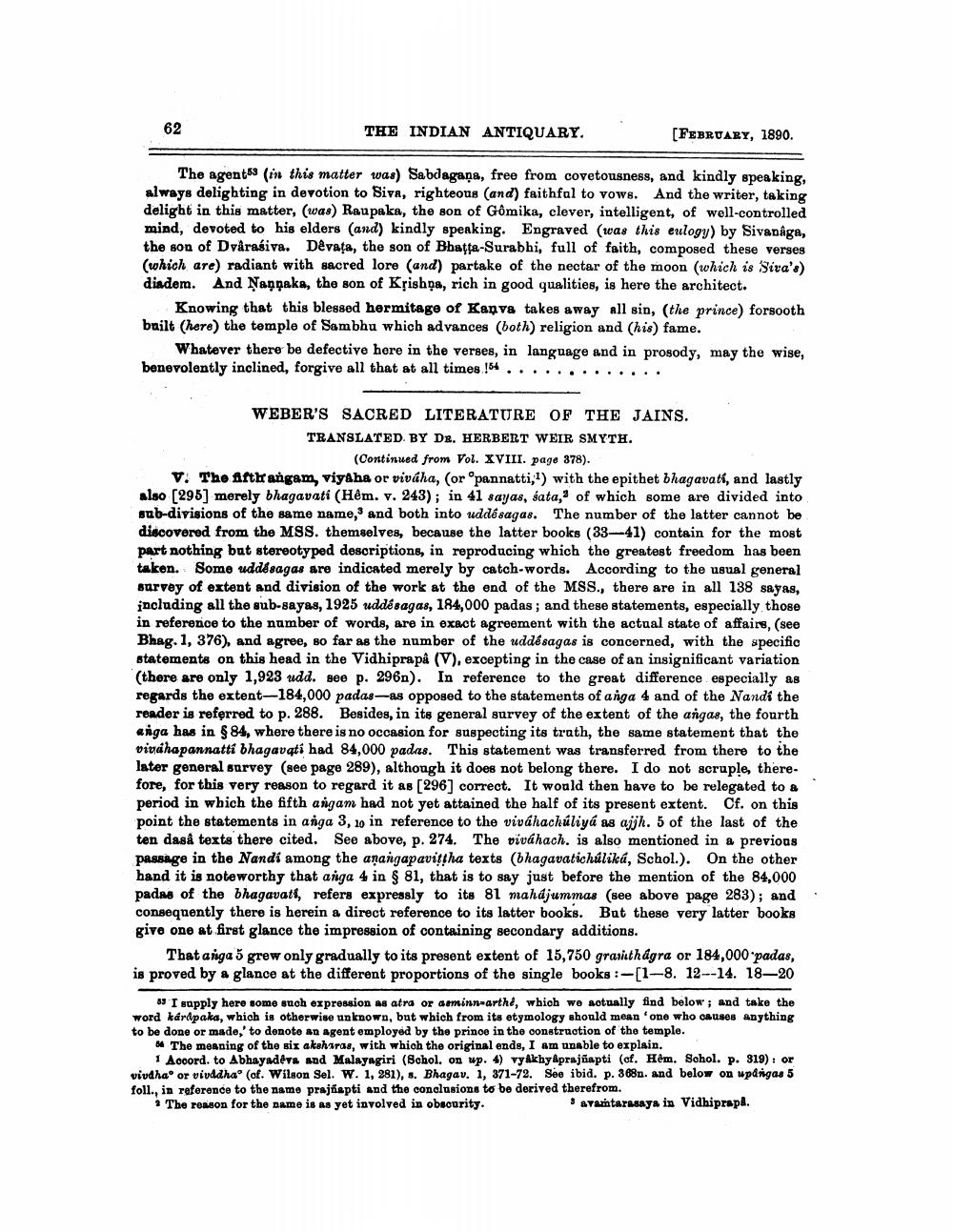________________
THE INDIAN ANTIQUARY.
[FEBRUARY, 1890.
The agents in this matter was) Sabdagana, free from covetousness, and kindly speaking, always delighting in devotion to Siva, righteous (and) faithful to vows. And the writer, taking delight in this matter, (was) Raupaka, the son of Gômika, clever, intelligent, of well-controlled mind, devoted to his elders (and) kindly speaking. Engraved (was this eulogy) by Sivanaga, the son of Dvårasiva. Dêvata, the son of Bhatta-Surabhi, full of faith, composed these verses (which are) radiant with sacred lore (and) partake of the nectar of the moon (which is Siva's) diadem. And Nagpaka, the son of Kțishņa, rich in good qualities, is here the architect.
Knowing that this blessed hermitage of Kanva takes away all sin, (the prince) forsooth bailt (here) the temple of Sambhu which advances (both) religion and (his) fame.
Whatever there be defective here in the verses, in language and in prosody, may the wise, benevolently inclined, forgive all that at all times 154..
WEBER'S SACRED LITERATURE OF THE JAINS.
TRANSLATED BY DR. HERBERT WEIR SMYTH.
(Continued from Vol. XVIII. page 378). V. The fifthangam, viyAha or viváha, (or opannatti,') with the epithet bhagavati, and lastly also [295] merely bhagavati (Hêm. v. 243); in 41 sayas, sata, of which some are divided into sub-divisions of the same name, and both into uddésagas. The number of the latter cannot be discovered from the MSS. themselves, because the latter books (33–41) contain for the most part nothing but stereotyped descriptions, in reproducing which the greatest freedom has been taken. Some uddá sagas are indicated merely by catch-words. According to the usual general survey of extent and division of the work at the end of the MSS., there are in all 138 sayas, including all the sub-sayas, 1925 uddésagas, 184,000 padas; and these statements, especially those in reference to the number of words, are in exact agreement with the actual state of affairs, (see Bhag. 1, 376), and agree, so far as the number of the uddésagas is concerned, with the specific statements on this head in the Vidhiprapà (V), excepting in the case of an insignificant variation (there are only 1,923 udd. see p. 296n). In reference to the great difference especially as regards the extent-184,000 padas-as opposed to the statements of anga 4 and of the Nandi the reader is referred to p. 288. Besides, in its general survey of the extent of the angas, the fourth anga has in $ 84, where there is no occasion for suspecting its trath, the same statement that the vivahapannatti bhagavati had 84,000 padas. This statement was transferred from there to the later general survey (see page 289), although it does not belong there. I do not scruple, there. fore, for this very reason to regard it as [296] correct. It would then have to be relegated to a period in which the fifth angam had not yet attained the half of its present extent. Cf. on this point the statements in anga 3, 10 in reference to the viváhachúliyá as ajjh. 5 of the last of the ten daså texts there cited. See above, p. 274. The viváhach. is also mentioned in a previous passage in the Nandi among the anangapavitha texts (bhagavatichúliká, Schol.). On the other hand it is noteworthy that anga 4 in $ 81, that is to say just before the mention of the 84,000 padas of the bhagavati, refers expressly to its 81 mahdjummas (see above page 283); and consequently there is herein a direct reference to its latter books. But these very latter books give one at first glance the impression of containing secondary additions.
That anga 5 grew only gradually to its present extent of 15,750 grarthagra or 184,000 padas, is proved by a glance at the different proportions of the single books :-[1-8. 12--14. 18-20
69 I supply here some such expression as atra or amminn-arthd, which we actually find below; and take the word kardpaka, which is otherwise unknown, but which from its etymology should mean 'one who causes anything to be done or made,' to denoto an agent employed by the prince in the construction of the temple.
* The meaning of the six aksharas, with which the original ends, I am unable to explain.
1 Acoord. to Abhayaders and Malayagiri (Schol. on up. 4) vy Akhy Aprajfapti (of. Hém. Schol. p. 319). or vivdha or vivddha' (of. Wilson Sel. W. 1, 281), s. Bhagav. 1, 371-72. See ibid. p. 368n. and below on upangas 5 foll., in reference to the namo prajíepti and the conclusions to be derived therefrom. The reason for the name is as yet involved in obscurity.
avatar saya in Vidhiprapa.




